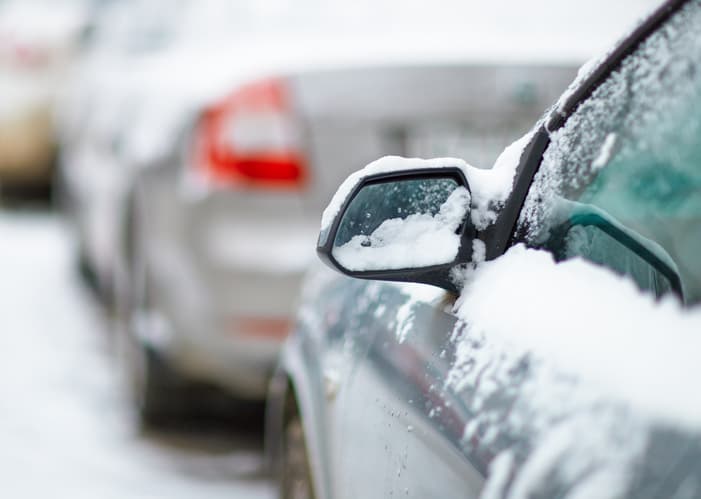The Stopping Distance Of A Car In Winter
Know When You Should Apply The Brakes

Wintery conditions can make driving much more difficult. High winds, heavy rain, dense fog and slippery roads can pose serious problems for even the most experienced driver, leading to crashes, near misses and plenty of delays.
One of the biggest problems facing road users is the change in stopping distance. You’ll be used to how long it takes for your car to stop in normal conditions, but when winter strikes everything you know goes out the window.
Brakes take longer to work. Wheels lose traction. You may even struggle to steer.
This all makes a difference to how long it takes your car to stop. At 120km/h on a motorway, it takes around 96 metres for your car to come to a standstill. Add winter into the mix and this distance is doubled, taking you 192 metres. All of this could cause a serious, and potentially fatal, collision.
WHY DOES YOUR CAR STOPPING DISTANCE CHANGE IN WINTER
There are a few different reasons why it will take your car longer to stop during winter. While they might not all happen at the same time, there’s a good chance you’ll run into one of them when driving in Ireland.
Stopping Distance In Wet Conditions
Rain reduces your tyres’ grip on the road. In especially heavy rain, it can form a layer of liquid between your wheels and the road, preventing your breaks from working at all. This is called hydroplaning, which can be terrifying if you ever experience it.
Rain can also decrease your visibility, which might mean your reaction times are slower.
Advice suggests leaving a gap twice as big between you and the car in front during wet driving conditions.
Stopping Distance In Windy Conditions
You might not think of wind as being something that could impact your stopping distance, but it can add real hazards to the road. Not only can wind cause your car to move sideways (never a great experience), it can also blow debris into your path and reduce visibility, meaning you take longer to hit the brakes. A wind behind you can even increase your speed without you noticing.
Now let’s talk about lorries. High-sided vehicles are even more susceptible to wind than other road users, and a heavy gust could see them topple over. Take care when overtaking them, and try to keep your distance if following one on the road.
Stopping Distances In Ice And Snow
Ice is possibly the thing you most closely associate with poor braking conditions, and the reason is simple: it makes things slippery. Your grip on the road will be severely reduced, making it almost impossible to stop, accelerate or turn your steering wheel. Need to make a hill start? Rather you than us.
Snow can also be very dangerous. The soft, fluffy stuff that’s fun to play in is awful to drive in. As you drive over it, your car will compress the snow, turning it into slippery sludge that has a similar effect to ice.
Thick snow can also make turning a challenge. Your wheels will get stuck in the grooves left by other drivers, and if you try to leave those grooves you could easily skid. Add to that how poor visibility is when driving in snow, and you’ve got some pretty awful driving conditions.
Stopping in ice and snow could take you 10 times longer than in normal conditions.
HOW TO PREPARE YOUR CAR FOR DRIVING IN WINTER
As much as nature might try to work against you during winter, there are things you can do to keep your driving as safe as possible.
- Top Up Your Windscreen Washer And Antifreeze
- Check Your Tyre Pressure
- Check Your Tyre Tread
- Keep Your Fuel Topped Up
- Take A Breakdown Kit
Driving in winter can make your windscreen filthy. Dirt kicked up by other drivers, rain, snow, and all those leaves that gather under your windscreen wipers can make it hard to see. It’s illegal to drive without sufficient washer fluid, so make sure you’re topped up.
Top it up regularly, clean the nozzles, and don’t forget antifreeze. This will stop your washer fluid from freezing up if the weather gets especially cold.
Deflated tyres will severely reduce your grip, increasing your stopping distance and making it unsafe to drive. You can pick up penalty points on your licence if you’re found to have insufficiency tyre tread. Take some spare change to the petrol station and get your tyres pumped up.
Tyre tread will naturally decrease over time, so it’s always good to get it checked over before driving in wintry conditions. Your annual service should do this for you, but it’s good practice to do it yourself before heading out. The minimum required tread depth by law is 1.66mm, but to be safe this should be as deep as 3.0mm.
Running out of fuel on a winter’s night doesn’t sound like fun to us. Keep your fuel tank at least half full to reduce the risk of running out. This is especially important due to the amount of delays you might be stuck in during bad conditions, potentially using fuel up faster than normal.
Packing things like a blanket, torch, fully charged phone, water and some snacks could (literally) be a life saver if you break down in winter. At the very least, it’ll keep you comfortable while you wait for a recovery vehicle to come and get you.
CAR INSURANCE WILL KEEP YOU COVERED, JUST IN CASE THE WORST HAPPENS
Driving in winter doesn’t have to be scary, but it can certainly pose a few more risks than usual. If your car insurance is up for renewal, now could be a great time to compare our car insurance quotes. Make sure you’re covered, make sure you’re saving money, and make sure you’re safe in case the weather takes a turn for the worse.

